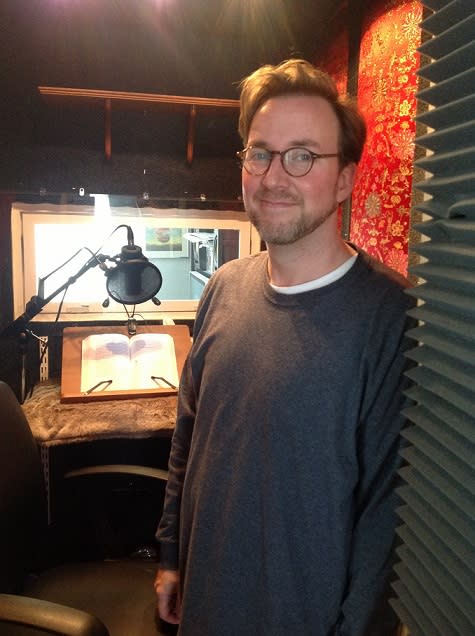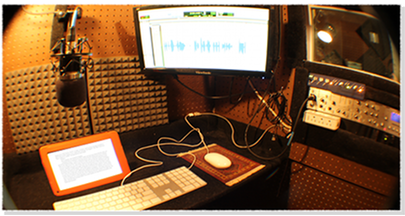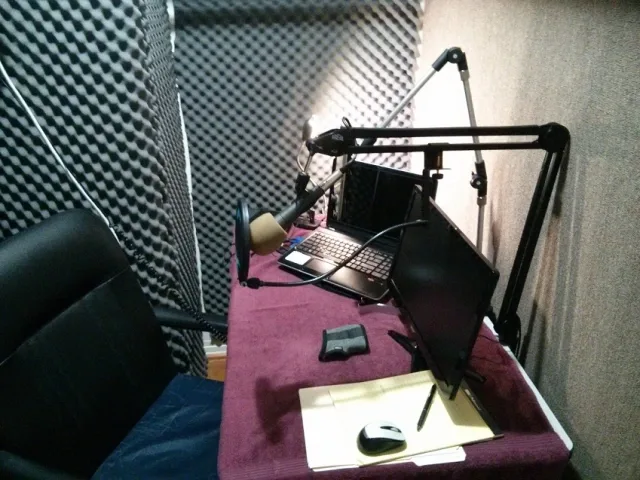ACX Studio Gear Series: Home Studio Setup – Part 1
Posted on October 17, 2013 by Scott Jacobi
If you’re a regular reader of the ACX blog, you know we’ve been working our way through the list of items you’ll need for a professional sounding home recording studio. But what about the setup of the studio itself? Over the next few posts, we’ll be joined by expert and prolific producers from Audible Studios and ACX, who’ll offer their tips for the essential elements of home studio construction.
Today, we talk to ACX engineers, an author who built a home studio to narrate his own books, and our own Audible Studios staff about the importance of using high quality equipment and working with the noisy quirks of your unique recording space.
ACX: In your opinion, what are the most important elements of home studio construction?

Peter A. Rohan, ACX Producer: You’ve got to start with the right equipment. Use a “quiet” mic that gives you the best frequency results for your voice. Choose an interface with a good preamp that provides quality analog to digital (a/d) and digital to analog (d/a) conversion and that will not introduce a lot of noise. A budget mic and inferior interface can introduce an amount of noise and contribute to your overall noise floor. I found that out the hard way, after exhausting all my energies in soundproofing and absorption only to find that it was the cheap mic that I was using that was generating most of my noise floor.
Darren Vermaas, Audible Studios Post-Production Associate: Definitely don’t skimp on the equipment. Using proper gear in the first steps of recording is going to make your life a lot easier in the end. Besides saving you time in post-production editing out noises and trying to figure out how to bring your overall noise floor down, it will simply make your book sound more professional.
Rob Granniss, Brick Shop Audiobooks: Get as good a mic, headphones, preamp and DAW as you can. Then get to know them as well as you can. Compare them with every other reference possible, including your laptop speakers, your cellphone, your audio geek friend’s sound system, etc. Listen to the same source material on each and note differences. Listen to your own recordings on those sources, as well as professionally produced recordings (voice as well as music if you’d like). The comparison isn’t to find what you like or what is “true” but rather to find what’s missing or is too enhanced about your own setup.

Peter: Also, be wary of cooling fans and keep them away from your mic. Avoid recording with your laptop near the microphone or anything else with a cooling fan that turns on and off as the temperature fluctuates.
Darren: Get away from noises. That ticking clock, running refrigerator, dogs barking outside your window at the loud trucks driving by, and (of course) that fan running in your computer are all potential hazards. These are all real things I’ve heard come through in recordings here. The last example is one of the most important to consider.
You will discover a lot of things about your room while you’re setting up a home studio. Noises you’ve never paid mind to are going to start jumping out, and you’ll have to figure out how to deal with them. When I needed to record vocals in my noisy 5 story apartment building with window AC units, you could find me hanging packing blankets and winter coats in my closet, positioning a microphone in there, and sweating it out while recording to make sure it sounded good. Not glamorous, and not comfortable, but it did sound good!

Stephen Woodfin, ACX Author/Narrator:
Without a doubt the single best thing I did was to read and study the information on ACX about what is involved in the process of setting up a home studio. I found that information practical and concise and used it as a blueprint each step along the way. I supplemented the ACX material by watching YouTube videos about the construction of home studios. In addition to watching videos, I read blogs and bought several books that provided more in depth discussions of audio production and equipment. From these books I was able to determine which equipment was essential for my purposes and which optional. I also learned that it wasn’t necessary to buy the most expensive equipment available because there are economical ways to build a studio capable of producing first-rate audio without skimping.
Check back with us next week for more for more expert discussion on home studio setup!
What do you think is the most important aspect of building a home studio?